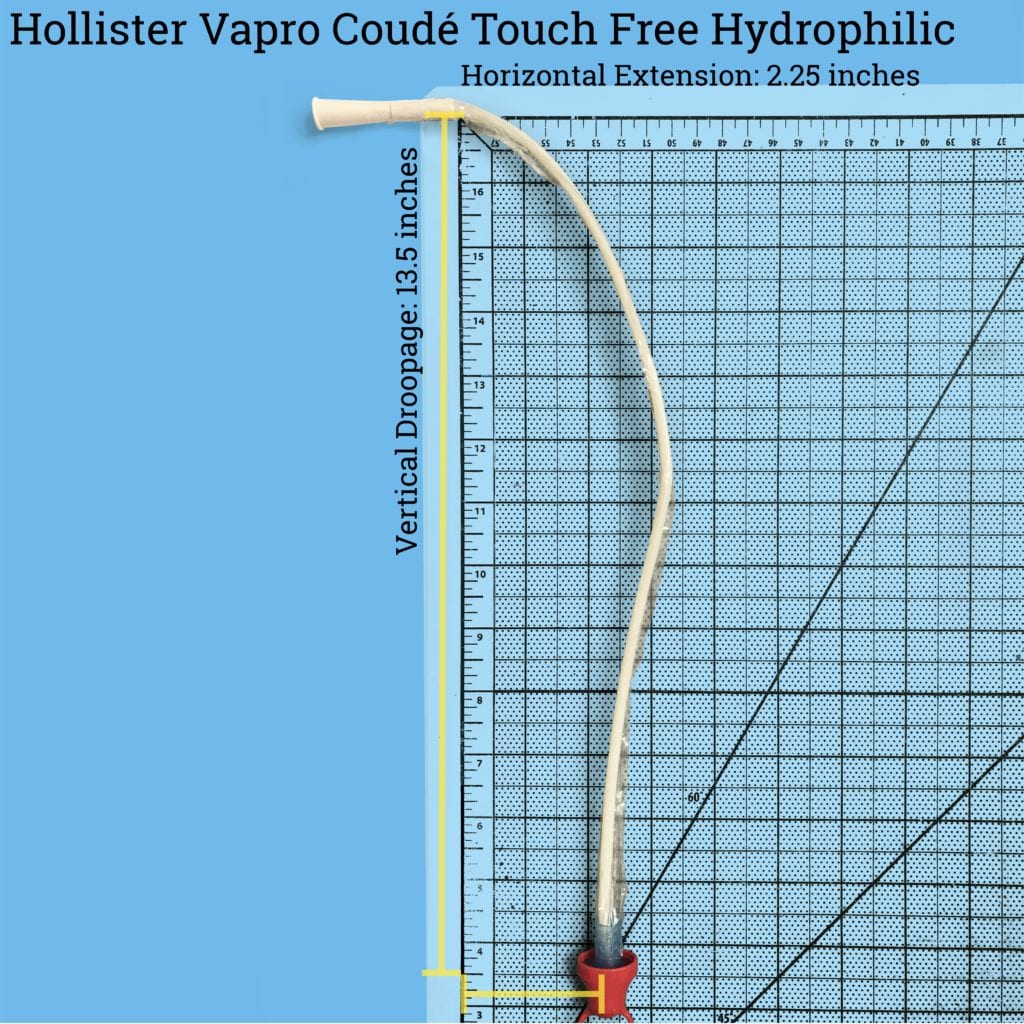Hollister® VaPro™ Coudé Touch Free

Product Overview
Available Lengths: 16 inches (Male)
Available French Sizes: Fr 12, 14, 16
Available Tips: Coudé only
Pros
This catheter comes with all of the protections that you might need to prevent contact contamination of your catheters and will likely help reduce urinary tract infections.
Really thoughtful packaging design to ensure ease of use.
Our Verdict
A solid catheter with a price tag to match.
Cons
This is an expensive catheter and it may be difficult to get insurance coverage for it.
The catheter that we tested had an uneven coating of lubricant on its surface, which may translate to discomfort while inserting it – plus the entire catheter is wet when you remove it from the packaging.
Limited temperature range means that you should be careful when you’re carrying this product around.
The catheter has a distinct smell – like a science lab.
Material
The Hollister® VaPro™ Coudé Touch Free Hydrophilic Catheter is made out of PVC with a PVP (polyvinylpyrollidone) hydrophilic coating. It’s an example of a no-touch catheter. The PVC is certified to be phthalate free, which means it does not contain DEHP, unlike a few other PVC catheters like the Coloplast® Self-Cath or the Bard® Clean-Cath®. Reports in the published literature note that use of PVC can be associated with negative health effects in humans and that its manufacture can be associated with negative environmental impacts.
More on PVP below in the lubrication section!
Flexibility

This catheter is incredibly droopy – the catheter that we tested dropped down 13.5 inches and extended horizontally 2.25 inches – which we would normally consider to be a bad thing. Given that it’s a hydrophilic catheter packaged with an introducer tip and an insertion sleeve, you don’t run into the same issues that you would with trying to lubricate and insert a non-coated flexible catheter.
Packaging
This catheter has well considered packaging. Like many other hydrophilic and more premium products, the packaging has easy-open tear holes, but Hollister goes one step further and has two separate areas where users can insert their fingers and open the packaging. The top easy-open tear hole connects to a pull strip which runs down the length of the packaging, facilitating an opening along the entire package. Because the catheter is shielded from direct contact, there is less need to worry about contact contamination when opening the product this way.
The package itself is made out of foil, likely to prevent water vapor from escaping the packaging which would dry out the catheter. There is an absorbent plastic-like material on one side of the packaging, likely to ensure that there isn’t an overwhelming amount of moisture in the packaging, but also to ensure that the catheter is adequately hydrated. It’s still wet when you open it, make no mistake, and a vague science-y, anatomy lab preservative smell pervades throughout the product.

The catheter’s introducer tip comes pre-packaged in a protective cap to make sure that it doesn’t contact any contaminants until you’re ready to insert it into the body.
Lubrication
PVP is the hydrophilic coating that gives this catheter its lubricious quality. PVP is generally considered to be safe, but can cause allergic reactions in rare cases – so check with your physician if you’re unsure as to whether or not this catheter is right for you.
The catheter comes pre-lubricated using water vapor, and the packaging generally does a good job of keeping the catheter most before it is opened. That being said, because the catheter doesn’t self-lubricate the way that a Bard Magic3 GO® catheter does, you’ll want to make sure you use it soon after opening it. Otherwise the touchless sleeve can stick to the catheter and dry, rough residue is left on its surface. In fact, even when the catheter is hydrated, you can feel some unevenness on the surface of the catheter, one that we didn’t notice on Bard or Wellspect’s products.
The packaging indicates to keep the catheter stored between 59F and 86F, which is helpful to know if you’re traveling with the catheter or spending extended time outside of that temperature range.
The water vapor does give the entire catheter a slick and wet feel, and some users may be put off from that.
Insertion
Instructional videos for this product can be found here.
Insertion with this catheter is really a breeze. Hollister has thought of most causes of contact contamination – the insertion sleeve and introducer tip help reduce the odds of contact contamination per clinical evidence available on the Hollister website. Critically, some of the studies in this document were independently conducted (not paid for by Hollister), including one where the use of an introducer tip was specifically tied to decreased UTI incidence rate.
Make no mistake, this is a more expensive catheter, and not everyone will receive insurance coverage for it. To put that more concretely, Medicare will usually recognize the cost of this type of catheter (A4352) as at least $6.35 per catheter. Because it’s a coude-tipped catheter, coverage is usually limited to men with a documentation showing that they have an enlarged prostate that normally blocks the flow of urine from the bladder.
Adverse Events
There were just 2 complaints filed with the FDA about the VaPro™ Coudé Touch Free Hydrophilic® catheter in 2019. Both complains had to do with the catheter arriving twisted in the packaging, with one complaint citing that the coudé tip was folded down over itself, which contributed to the development of a UTI after it was used.
 The review of FDA Medical Device Reports from 2019 provides a limited snapshot of recent product performance in the marketplace.
The review of FDA Medical Device Reports from 2019 provides a limited snapshot of recent product performance in the marketplace.